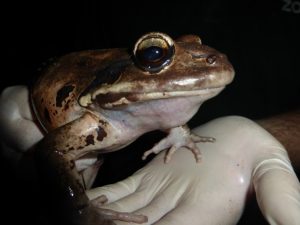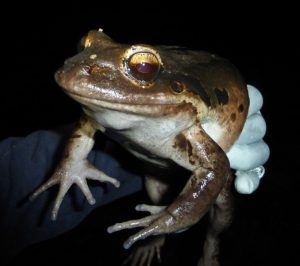Follow up monitoring
Moving the two frogs together, whilst the most important component, was just the first stage. As nothing like this had been done on this level with amphibians before we did not know what would happen. One of the major concerns was that the female would immediately try to get back to her original patch. For this reason undertaking nightly post-move monitoring was vitally important.
The following night we all returned to check on them and see if the female was still there. She was, which was encouraging but we knew it was early days and we’d be much more confident of her staying put if she was still there a week or so later.

I left Montserrat that Wednesday 29 June, leaving the rest of the post-move monitoring in the very capable hands of Blacka, Luke and Katy. The following nightly visits to Fairy Walk, like my initial visits, though proved to be frustratingly frog free. However, the following Tuesday 5 July, nine days since the translocation took place the female was seen again in the translocation area. Finding her there, that long after moving her gives us confidence that she is likely to now stay around that area.
Both Luke and Katy left Montserrat the weekend just gone (9 and 10 July) without seeing

the female again and weekly monitoring will now be continued by Blacka and the DOE. This will provide us with continued information on their general status and hopefully on whether any breeding has taken place. Mountain chickens have a unique breeding behaviour, making nests in burrows, where they lay just a relatively small number of eggs (10 to 80). Both parents guard the nest and show a high degree of parental care. According to Blacka when they have a nest the parents can get quite aggressive in defending it, even charging you, and seeing them exhibit this type of behaviour would be an indication of successful breeding. Aside from that the first confirmation of successful breeding would likely be next year when juvenile frogs may be seen during surveys in the area.
Next steps and final words
We all hope that the pair do breed and produce offspring as that would be the ultimate success of this translocation. If this occurs it will be the first time mountain chickens have been known to breed on Montserrat since 2009. Any offspring produced will also provide an additional and very important gene pool to complement those individuals currently being held in bio-secure captive conditions in the four MCRP partner zoos. This will benefit the next stage of research on Montserrat, which will involve establishing a semi-wild enclosure for mountain chickens. In this we will trial environmental manipulation measures to create safe ‘refuges’ from the effects of chytrid, which will enable the species to persist in the wild alongside the fungus.
Of course, we cannot guarantee that they will breed and offspring will be produced but what we can say is that we have enabled the conditions for this to occur by moving the two frogs into the same location. Without doing that the only guarantee would be that they would not have bred. I hope this is just the first chapter in these two frog’s story and that there will be much more to tell over the forthcoming years. Finally, thanks go to all the MCRP partners for their support and advice through this, the generous donors to Durrell’s online appeal and all those who trekked night after night into Fairy Walk to unite these frogs – Calvin ‘Blacka’ Fenton, Luke Harding, Katy Upton and Steph Jayson.
Our handsome male…

…and beautiful female.

Jeff Dawson, Amphibian Programme Manager, Durrell Wildlife Conservation Trust








Hi,
I’m a university student studying geography and I’m producing a report on the conservation status of the mountain chicken. Could you possibly let me know if there are any recent updates? Whether that’s individuals remaining, or updates on any of the remedies to the crisis.
Many thanks,
Miles